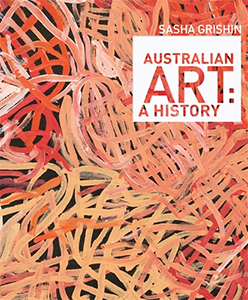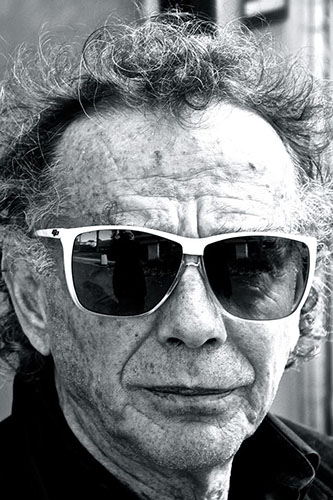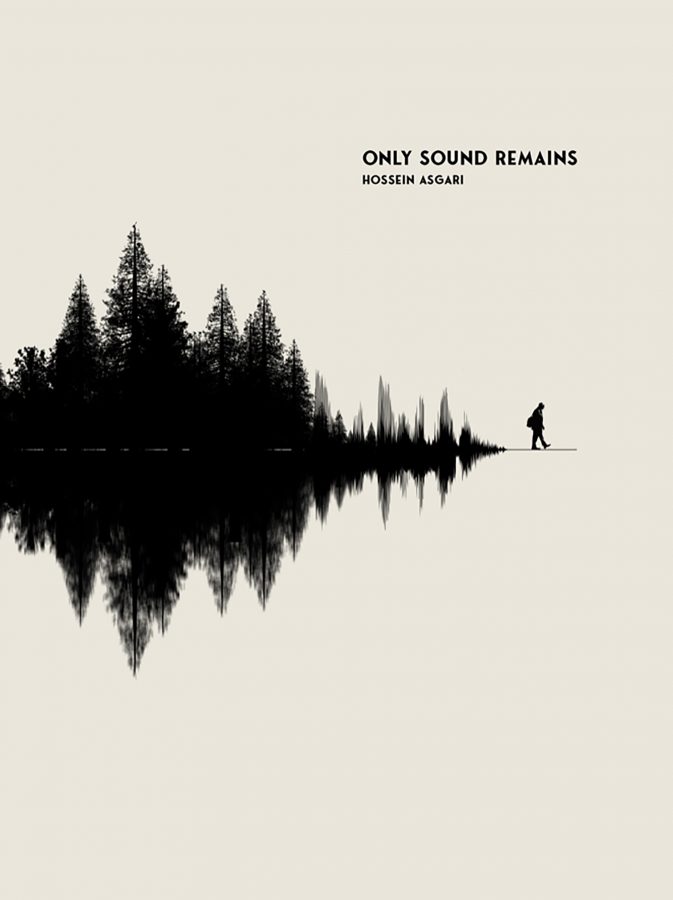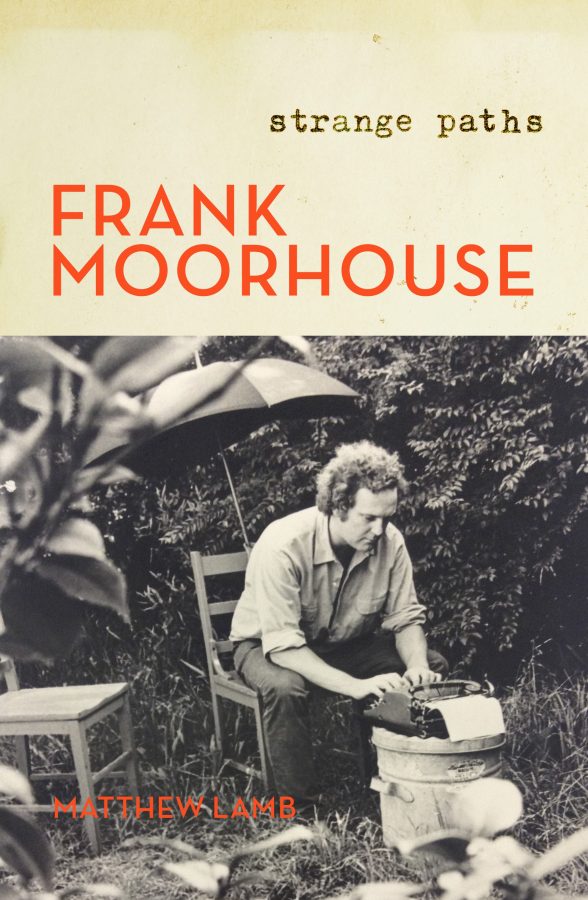Stranger than we can imagine: Australian Art: A History by Sasha Grishin
This is a peculiar book. But then, art history is a peculiar discipline. It is, you might say, three dimensional. There is the art, which is real and tangible and, in most cases, dateable. Then there is its history, with its sequences and sources, debts and influences. Finally, there is the historical time in which the art was made, which may be dateable, but is in other respects more nebulous, as is its relationship with the other two dimensions. Art historians often assume that the larger history is in some sense as tangible as the art and its sequences, and further that there is an easily explicable connection between the two – between, for instance, the allegedly nationalistic art of the painters of the Heidelberg School and the push toward Federation in the 1890s. The assumption that history is something that really exists and may be uncovered might or might not be valid; even so, art historians generally do not inquire very deeply into historical matters, preferring simply to evoke them in passing, as context.
One of the unexamined consequences of the assumption that there is a direct relation between art and the times in which it was made is that geological, archaeological and even teleological metaphors are imported into art historical texts. Another, perhaps related, consequence is the prevalence of the idea that there is a central narrative whose lineaments it is the art historian’s task to uncover. This mode of thought assumes the grand narrative really does exist and so may be, with diligent research, re-constituted. This is very different from the scholarly work of history – or geology or archaeology, for that matter – where evidence is one thing and interpretation another. Art historians tend to assume evidence and interpretation are coeval, and are thus likely to allude vaguely to the times in which art was made and then move quickly on to their real interest, which is the art itself.
But the scaffolding of time in art historical studies does have consequences. One, pertinent here, is that the assumption of a central narrative’s existence has an effect upon what is or is not included within it. Key artists will be privileged because they have always fitted in, while others, who never fitted, are consigned once more to obscurity. They represent by-ways, irrelevancies, alternative pathways – all leading to dead ends. The central narrative thus becomes in some sense self-replicating. Those artists who have previously been adjudged eminent, whose works have been widely reproduced or exhibited or bought by major galleries, exert a kind of gravitational pull upon the construction of the chronology. You can leave out, say, Walter Withers or Arthur Loreiro; but you can’t leave out Tom Roberts or Arthur Streeton.
Furthermore, because art historians so rarely question the assumptions behind the history that provides them with their chronological scaffold, they are often blind to the notion that any re-telling of history, artistic or otherwise, is a prospective act. Art historians like to indulge the pretense that their studies are retrospective and dispassionate, when they are, like all histories, as much about the present and the future as about the past. The danger in histories which do not know, or do not acknowledge, that they are prospective is that they will, in their adherence to received knowledge, miss crucial alternative pathways: those roads not taken which might still be worth pursuing. They will miss, in other words, those parts of the past that may serve to illuminate a contested present or open up an alternative future.
Revisionist, indeed polemical, art histories are possible, although they tend to revise the art and its sequences – its ‘place’ in history – not the history itself. Sasha Grishin’s version, Australian Art: A History, is neither polemical nor revisionist; but it is curious. He takes what he considers to be an innovative, inclusive approach, beginning bravely with the assertion that his history is neither written piece-meal by a committee of experts, nor a frolic of his own, but combines both approaches: ‘I assembled,’ he writes, ‘a “council of twenty elders” in the discipline, each of which was invited to critique the section of the manuscript that corresponded with their area of expertise.’ For the final section of the four part book, this ‘tribal’ approach was augmented by consultation with dozens of practising artists, as well as contemporary critics, curators and scholars, in order to determine the fifty living artists ‘whose practice is integral to any discussion of contemporary art making’. The list of these fifty living practitioners, and the names of those consultant artists, critics, curators, dealers and scholars, together with their recommendations, would have made fascinating reading, but are not included. Nor is their contribution in any way traceable in the text which, despite his wide consultation, is emphatically Grishin’s own.
‘Another significant departure from most extant models,’ writes Grishin, ‘is the location of indigenous art practice . . . a continuous dialectic between indigenous and non-indigenous art is a constant theme.’ And he is ecumenical with regard to theory: ‘There is no single guiding methodological framework that is dogmatically applied,’ he states, and then acknowledges a large number of mostly French, mostly twentieth century theorists whose work he has read and, here and there, applied. Their names are recorded; this becomes the first of many lists of names. With respect to gender, while he does not specify an intention to foreground – or at least de-background – the work of women artists, his text in places betrays an almost plaintive anxiety lest he be seen to be excluding women’s work from the discussion. If they are omitted, he seems at times to say, it is because they truly did not exist.
The result is a series of illustrated essays of varying quality – some excellent, some mediocre – which are continually being pulled out of shape by the twin demands of biography and chronology, within a conceptual framework that is historically incoherent. There are 46 of these essays, or chapters, in four sections. The sections, with the exception of the first, oddly entitled ‘Terra Nullius’, each cover more or less half a century. ‘Terra Nullius’ takes us from the Dreamtime to Conrad Marten; the second section, from the gold rushes in the 1850s into Edwardian times; the third, from Federation to the mid-twentieth century; the fourth from the 1950s until now. The arrangement of essays within these deliberately over-lapping sections is loosely but not strictly chronological; and there is no clear rationale I can find for the four part structure. The decision to break the first two sections about mid-century, for instance, makes no sense; nor does the similarly blurred partition of the twentieth century into two. Both seem arbitrary in historical and art historical terms alike.
It is a shame that Grishin did not use, or perhaps was not aware of, the framework suggested recently by Ian McLean, while writing about the exhibition Australia at the Royal Academy, which opened last year in London. McLean advocates a three part historical structure based around themes of identity and landscape: Empire Art (1788–1918), Australian Art (1918-1970) and post-Australian Art (1970-present). Following Ian Burn, he proposes that ‘being Australian’ did not become a subject of Australian art until after the First World War, and that until then most developments here can be seen in an international context – that is, as a product of the British Empire. Moreover, the second break point, significantly, takes account of two major events: the first was the 1969 wrapping, by Christo Javacheff and Jean-Claude de Guillebon, of the coastline at Little Bay; the second, a year or two later, was the beginning of the Papunya Tula movement, which inaugurated the flowering of the desert art movement, still the only example of an Australian art movement with an emphatic international profile.
Grishin identifies dialogue between indigenous and non-indigenous art as a major theme. How does this play out? He begins his history with a discussion of pre-contact indigenous art, concentrating upon the Kimberley and the Top End. He considers the Bradshaw figures, the Wandjina tradition and the X-Ray style – with a few references to rock art as a practice found, in varying forms, all over the continent. His remarks follow the standard interpretations in archaeological texts, apart from a digression into explorer, and later colonial governor, George Grey’s 1830s versions of Wandjina paintings from the Kimberley and the bizarre theories advanced during the later nineteenth century to account for them. The digression is entertaining as far as it goes, but strictly speaking irrelevant; it is simply not the case that Grey’s versions were, as Grishin claims, highly influential. My suspicion is that he has sourced his material from Paul Carter’s The Road to Botany Bay (1987), in which Grey and his drawings feature prominently. The Wandjina tradition is unbroken and of interest in its own right, but it receives only cursory attention. There would have been more point to a sustained inquiry into what the Bradshaw figures represent, and their nascent connection to living traditions in the Top End. This is the first of a number of missed opportunities.
Grishin’s essay on the art that arose from early exploring expeditions to the Great South Land is perfunctory. It deals briefly with the productions of the James Cook / Joseph Banks expedition and, some years later, those from the voyage of Nicolas Baudin. There are some illuminating passages about post-1788 art, notably the insight that artists, like the unidentified Port Jackson painter, incorporated into their pictures repetitive, patterned motifs apparently derived from indigenous sources. But the opportunity to develop this point with reference to convict artists, such as Richard Browne and Joseph Lycett, is lost when Grishin again indulges his penchant for digression. In the case of Browne, an account of European ideas about phrenology serves to characterise Browne’s (to our eyes) distorted portraits of Aboriginal people. As Grishin himself admits, however, there is no evidence that Browne was aware of this tradition, and in the extended discussion of an irrelevancy, he fails to acknowledge that Browne’s portraits, especially those he made in Newcastle, were ethnographically precise and are today regarded by Awabakal people as authentic representations of known, named ancestors.
Joseph Lycett, like Browne, was ethnographically precise and his work has attained totemic significance among descendants of the people he painted. His signature painting, in oils, of a corroboree in Newcastle is not mentioned; nor are his remarkable oil paintings on the Macquarie and Dixon chests; nor his extraordinarily vivid landscapes from the Derby Album. Even the so-called Lycett Album is damned with faint praise, mainly because the artist clothed his indigenous subjects in white loincloths. His close observation of, and interaction with, his indigenous subjects is ignored. Instead, we are given an extended, highly critical discussion of the Englishing of Australian landscapes in Lycett’s Views in Australia (1824-5) – a discussion which ignores the probability that most of the engravings for this work were done, not by Lycett himself, but by London-based journeyman artists who had never seen the places depicted. The likelihood is that Browne’s paintings of Aborigines are distorted because that is how he saw these new and unfamiliar people; and that Lycett’s landscapes seem park-like and therefore superficially English because, as Bill Gammage’s account of firestick farming in The Biggest Estate on Earth (2011) makes clear, that is how the environs of early New South Wales settlements actually appeared.
What Grishin is doing here, in a rather tired and time-lapsed manner, is lamenting the Europeanisation of both Aboriginality and landscape. This comes startlingly into focus when he quotes a 50-year-old remark by poet Geoffrey Dutton that convicts were primarily responsible for the brutalisation of Aborigines in the contact period. Contemporary historians like Grace Karskens have shown that, while some convicts did commit outrages against some Aborigines, there were others who established mutually beneficial, sustaining relationships with indigenous communities, to the extent that when, in 1816, Governor Macquarie sent redcoats on punitive expeditions against turbulent tribes in the interior, white convict settlers deliberately sabotaged operations in order to protect the local Tharawal people, with whom they lived in a kind of symbiosis.
Grishin’s account of nineteenth century Aboriginal artists such as Tommy McRae and William Barak is sound, but abbreviated and oddly placed near the very beginning of the book. When he comes to the twentieth century, however, his text is seriously flawed. This is a shame because ‘the continuous dialectic between indigenous and non-indigenous art’ over the last hundred years or so is extraordinarily rich and complex. The first failure is Grishin’s inability to connect the production of Toa, sculptural objects of unknown purpose that were made in the early twentieth century at the Lutheran Mission at Killalpaninna in the Lake Eyre region, with the art innovations at the Lutheran’s sister mission at Hermannsburg, which nurtured the young Albert Namatjira. Harry Hillier, who taught Namatjira as a child, was a watercolour painter who apparently helped Dieri people in the production of Toa. A missionary, Oskar Liebler, bought some Toa to Hermannsburg in 1910 and their example probably influenced the production of souvenir pieces there in the 1920s, and subsequently led to Namatjira’s early efforts as a painter. Grishin illustrates Toa, but the plate introduces his chapter on the Papunya painters, thus eliding almost 70 years of art practice in the Centre.
His account of the collaboration between Namatjira and Reginald Battarbee that founded the Hermannsburg School appears elsewhere, introducing an essay on the Depression and the Second World War. Grishin neglects to mention that some of the Papunya artists knew and painted with Namatjira, or that Namatjira, convicted of alcohol related offences in 1958, served out his sentence at Papunya. This is an oversight comparable with the author’s failure to register that bark painting, too, may have mixed origins: there is at least a chance that the innovation of portable supports for the style, adopted in the Top End just before World War One, may have occurred at the instigation of European scholars, notably Baldwin Spencer, who was Protector of Aborigines in the Territory at the time.
Another aspect of the dialogue between indigenous and non-indigenous art is the representation of indigenes by their colonisers, and while Grishin is assiduous in his summaries, here too there are missed opportunities. His focus on the mid-century caricatures of Aborigines by S. T. Gill, and his concern to document those occasions when John Glover or Eugène von Guérard depicted Aborigines in their work, means he misses the chance to reproduce, or even discuss, Ludwig Becker’s superb naturalistic watercolour portraits of Aborigines painted in Tasmania and during the Burke and Wills expedition. Indeed, though he appears on several lists of artists, Becker is otherwise overlooked in favour of his more grandiloquent contemporaries: this is an example of a road not taken, since Becker’s tiny, jewel-like works are not simply valuable in their own right, they have also influenced subsequent, and contemporary, watercolour painters.
There are other roads not taken. While the chapter on Heide, John and Sunday Reed, Sidney Nolan and the Ern Malley affair is one of the better essays in the book, Grishin here misses another opportunity: he does not mention the presence in Adelaide, just after the war, of a group of surrealists which included the Czech, Dusan Marek and his brother Voitre, a sculptor, and the influence they exerted on (to name one example) the early works of Jeffrey Smart. Similarly, he does not document the loose group of artists, which included Ian Fairweather and David Strachan, gathered around Lina Bryans at the Pink Hotel on Melbourne’s outskirts during the World War Two; and he does not mention, even in passing, Mary Cockburn Mercer, who attended the banquet for Henri Rousseau in Paris in 1908, travelled widely between the wars, sometimes with her lover Janet Cumbrae Stewart, and in the early 1950s gave lessons in Melbourne to the young Colin McCahon, whose work has, in turn, influenced so many contemporary Australian artists. This is odd because Grishin, in his discussion of non-indigenous twentieth century art, is diligent in his documentation of influences and movements, and almost pathologically addicted to listing the names of artists who might have played a part, however small, in the great unfolding.
Of course, even in a book as weighty and imposing as this one, it is not possible to include everyone and everything, so choices have to be made. Once the Aboriginal art is out of the way, Grishin’s focus becomes determinedly Euro-centric. It deals almost exclusively with art produced in Melbourne and Sydney, or else by Melbournians or Sydneysiders who have made their careers overseas, mostly in London or Paris or, very occasionally, the United States. He is better at writing about Melbourne than about Sydney, and his accounts of expatriate artists, such as Peter John Russell, are usually and appropriately summaries. He largely eschews the anecdotal – there is no discussion of Russell’s destruction of hundreds of his works following the death of his wife – preferring the standard biographical format of date and place of birth of the artist, his or her teachers and influences, travel abroad (if any), followed by a summation of what the artist may have achieved. The major artists dealt with in each chapter have their works illustrated, and the illustrations are handsome and of uniformly high quality. While the balance between text and image is weighted conspicuously towards the sometimes convoluted text, Grishin is at his best when writing descriptively or analytically about those works he has decided to reproduce. He has a good eye for a painting too, and his choices are always interesting and sometimes inspired.
Major twentieth century artists, in this version, include Margaret Preston, who has a chapter more or less to herself; Hans Heysen, though more for his influence, it seems, than his actual work; Dorrit Black and Grace Cossington-Smith, Arthur Boyd and Sidney Nolan, Russell Drysdale and William Dobell; and, post-1950s, John Brack in Melbourne and John Olsen in Sydney. These latter choices seem determined in part by each man’s influence as a teacher; their work, while generously illustrated, is unconvincing, especially Brack’s bizarre later canvases on which he massed coloured pencils in battle lines to mimic, in one case, Waterloo. And it is difficult to forget one British reviewer’s unkind comment about the Olsen exhibited last year in London: ‘Jackson Pollock in swimming trunks’. Another, even more unkind, compared the ceiling mounted painting to an explosion of diarrhoea.
Even these major artists are to some extent casualties of the roller-coaster ride through the years that a book like this must undertake. The chronological structure means we frequently get snapshots of artists at particular points in time, not a full consideration of their careers. Nolan, for example, is not represented by any work completed after the Ned Kelly paintings of the 1940s, and there is no discussion or illustration of Boyd’s late landscapes painted at Bundanoon. This reflects not just limitations of space but the author’s bias towards urban as opposed to landscape painting. Fred Williams is given his due but William Robinson is not. The Rosalie Gascoigne works illustrated seem unrepresentative to me. Lloyd Rees is a regrettable omission; there is a paragraph discussing his work as a preface to the account of Fred Williams’ oeuvre, but no illustration. Brett Whiteley, controversially, is represented only by an etching with aquatint in a chapter on print-making; he may have produced acres of bad canvases but there are among them some significant and beautiful paintings, and I think the omission, for example, of his painted homage to Rees ‘The Road to Berry’ is a mistake. There is only one small Clarice Beckett painting illustrated, in a chapter where Grishin gives two rather ordinary (by his own admission) paintings – one by Arnold Shore, the other by Jock Frater – half a page each. I think this particular choice shows how Grishin is sometimes hide-bound by his self-imposed brief to reconstruct a pre-existent grand narrative.
Grishin’s philosophical preoccupations are Euro-centric too. He meditates on ‘the human condition’ and finds in the work of artists like Joy Hester or Bea Maddock evidence of an acquaintance with the tenets of existentialism. ‘Eschatological’ is a favoured word, as if an art piece could or would face us with the last things. He also demonstrates a beguiling preference for the humble and the hand-made above the glossy and the machined – there isn’t much abstract art in this book. And some of his inclusions are timely and significant: George Baldessin and Jan Senbergs, for instance, are each given proper consideration; and there is an extended discussion of the perhaps unfashionable work, in stained glass, of Leonard French. Typically, however, of a book such as this, architecture, ceramics, photography, print-making and sculpture, for reasons of space no doubt, are given little attention.
The impossibility, perhaps the absurdity, of enterprises such as this is emphasised in the final chapters, which squeeze in artists as various as Jeffrey Smart, Tony Tuckson, James Gleeson and Ken Whisson. The last chapter of all, ‘Australian Art in the Twenty-first Century’, gives us, among others, Bill Henson and Tracey Moffitt, Sally Smart and Lawrence Daws. There is a conspicuous absence of video or installation art and very little discussion of post-object art in general, although there is a nod in the direction of Mike Parr and his sister Julie Rrap. The long road to the far south concludes with an extended piece on Fiona Hall, which closes the book.
This end foregrounds another lack in the survey. Hall’s recent work has concerned itself with Pacific Island subject matter; she has made pieces that follow the Polynesian tradition of tapa cloth manufacture and decoration. There are other artists, notably the absent Gordon Crook, who have looked to the north and east for inspiration; and still others, like Ian Fairweather and Donald Friend, who found subject matter as well as stylistic influences in south-east Asia and China. The Euro-centricity of Grishin’s vision does not allow for much discussion of the Asia-Pacific as it has manifested in Australian art, nor of trans-Tasman contacts with New Zealand.
Despite its intention, Australian Art is not a history that looks very far into indigenous art traditions, whether or not they are in conversation with non-indigenous art. If it was, I would have expected more than just a mention, among contemporary artists, of people like Danie Mellor, Gordon Bennett, Imants Tillers and Joan Ross, all of whom have contributed in their work to the indigenous / non-indigenous conversation. Grishin’s preference is, in fact, for what used to be called high art. There is very little representation of craft or folk or naïve art, whether by that we mean Pro Hart, the shell constructions of Esme Timbery and Marilyn Russell, or the work of Ian Abdulla. Instead, Australian Art is concerned to trace lines of influence from the Old World; there is not a lot of discussion of American influences upon Australian art either.
This is a consequence of Grishin’s assumption that the general lines of Australian history are set, as it were, in stone. Expatriate artists in Great Britain and France in the Edwardian period are given a chapter each, when the space might have been more usefully employed in examining developments in the home country. The efflorescence of black and white art, for example, in magazines like the Bulletin and Smith’s Weekly before and after the First World War, is ignored. As is the influence that the Taos School of Artists exerted on practitioners of watercolour and landscape art in Melbourne in the 1920s and 1930s. Grishin’s treatment of war artists in both major twentieth century conflicts is also sparse; indeed, in the chapter devoted to the First World War he seems to lose interest and goes off instead on a digression surveying developments in Western Australia and in Queensland in the 1920s.
Nevertheless, in the areas of his chosen interests, Grishin is meticulous, exacting, sometimes illuminating, and demonstrates a preternatural ability to restore the often byzantine intricacies of the relationships between artists, teachers and critics in Sydney and Melbourne over the last hundred years or so. Which brings me back to the lists. Grishin has the encyclopedic impulse and is determined to preserve, as if on the plinth of a war memorial, the names of artists he is otherwise unable or unwilling to illustrate or discuss. This an endearing characteristic of the book and makes of its index a prodigy and a wonder. The documentation is, without exception, superb. This also means that, in our Google-dominated era, we can follow up on artists or movements as we wish. It highlights, too, the book’s most likely use: as a reference text. As such, it would be a valuable addition to the shelves of any school, university or public library. There, perhaps, its sometimes intimidating prose, and skewed text-to-image ratio, will not matter much, since it will likely be consulted on a case by case basis, rather than read, as I read it, from cover to cover.
Production standards are high and, for a text of this length, there are very few errors. Among the half dozen or so that I found, there is one that stands out, if only because I cannot conceive how the sentence was originally meant to read: ‘Early in life,’ Grishin writes, ‘Grace Crowley was cloned by Julian Ashton and the Sydney School of Art.’ The art world, to paraphrase astronomer Arthur Eddington, is not only stranger than we imagine, it is stranger than we can imagine. Despite its historical incoherence, this book does bear witness to that strangeness, as well as to the variousness, and the often enigmatic character, of Australian art.






